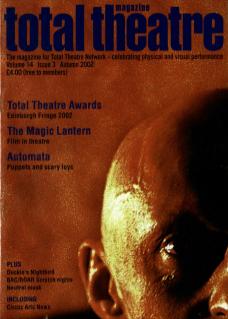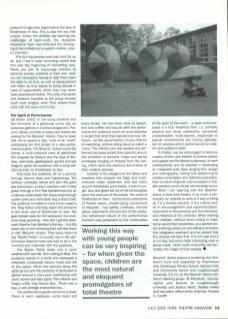There has been prolific debate about the definitions and scope of total theatre, with provocations offered and practices exchanged. One area of creative process and physical/visual performance which is not often reported is innovation in young people's total theatre.
Phil Gunderson's recent feature about the Fresh festival put the voices and experiences of young people in their teens and twenties as theatre goers and makers back into the mix. In response to Fresh participant Emma Baggott's call to start again, start with children and get them to play from a young age... and go on playing, this article will focus specifically on work by and with children and how their creativity contributes to growth and innovation in total theatre.
In Volume 12 Issue 2, Dorothy Max Prior proposed that total theatre is: ‘A collaboration between the performance space and everything that happens within it, including sound, movement and visual imagery.’ In Volume 14 Issue 1, Paul Miskin referred to the multi-disciplinary approach where 'a totality of art forms [are] unified as one expressive syntax’.
In my own work making performance with children it is the pursuit of a total experience (spiritual, physical, emotional, visual, vocal...) which motivates; as Paul Miskin calls it, ‘the totality of the human participants in the event... the theatre piece, the spectators and the performers'.
Total theatre is a process, a way of working, an ethos, which thrives on diversity and the creation of unity in diversity, in terms of methods, form, content and human experience. (By unity don't read neat and tidy, read unification of purpose and holistic approach, with space for dissonance and multiple meanings.) The collaboration, which transpires in the performance space between diverse performance elements, is the result of a process in which diversely disciplined artists and participants have consciously collaborated and played.
It's a risky, unpredictable business, but the potential for learning and creating 'out of the box' which is generated by working this way with young people can be very inspiring – for when given the space, children are the most natural and eloquent promulgators of total theatre.
Bloomin' Actors – making total theatre in collaboration with children
25 March 2002: Ali Maclaurin and I unload sound equipment, sari silks, sand and miscellaneous making materials into the community room in Shelthorpe School. We start with the space – the transformation of the space into another world, turning the familiar into something other (like the parallel universe accessed by Platform 9 3/4 in Harry Potter). Ali makes spiral paths of stones leading from a sand-filled rockpool; she also hangs the silks in swoops from the ceiling. There is a map hidden in the space and unfinished postcards from Shelthorpe on Sea. This suggestive space is the children's first physical and imaginative port of call: it will be the stimulus for the week's devising process.
The children and I enter the space as performer-explorers. We have set up the rules for the improvisation outside the room and agree to find out as much as we can about the world we discover through the doors. During the week the children work collaboratively with Ali (scenographer and visual artist), sound artist Oogoo Maia, and myself as performer and dramaturg, to create the places, characters, songs and stories of Shelthorpe on Sea. They engage in devising happenings which directly respond to the familiar physical surroundings of their school, and which also manifest their personal imaginative responses to the idea of Shelthorpe on Sea. This is also the very first project, where the children are learning the challenges of team-work, the discipline required to learn new skills and the developing of the confidence to explore creative, artistic impulses
The four-day process was hard work for us all, and I had to keep reminding myself that this was the beginning of something new. When you aim to encourage children to become primary creators of their own work you are necessarily having to help them leam the skills to do that, as well as being patient with them as they adjust to being placeel in roles of responsibility which they may never have experienced before. The unity of purpose and distance travelled by the group showed itself most tangibly when they shared their work with the local community.
The Spirit of Performance
28 March 2002: In low-slung shadows and the remnants of a gloriously sunny day an audience gathers in a school playground. Parents, babies and kids on bikes and boards are waiting for the Bloomin' Actors. They've been told not to expect a play, more of an 'event' celebrating the first phase of a new performance project. The Bloomin' Actors round the corner, a multi-coloured crew of plentimaw fish (inspired by Haroun and the Sea of Stories), mermaids, gatekeepers, guides and sea dragons, greet the audience with a song welcoming them to Shelthorpe on Sea.
They lead the audience off on a journey through various sites and happenings. Ten rainbow umbrellas dance and spin like giant sea anemones, a clown wanders with a baby guitar through a Trim Trail transformed into an undersea world where fish faces peep through rubber tyres and mermaids ring a ship's bell. The audience is invited to move on by a piper's trill. They follow until they reach the entrance to the inner cave of Shelthorpe on Sea. The gate keeper asks for the password; the audience keep guessing – they don't get the pass word Maxime has decided is the key – but she takes pity on one shivering Dad and lets them in with 'Bloomin' Actors'. They were meant to say 'Mystic Portal', of course, but in this performance Maxime knew she had to be in the moment and improvise with the audience.
The Mystic Portal leads into a room swathed with sari silk, from ceiling to floor. The audience stands in a circle and witnesses a mesmeric underwater dance; music and silk fill the space. When the dancers sleep the lights go out and the audience is beckoned to gather around a rock-pool overflowing with sand, stones and fairy lights. The children and Oogoo softly sing Nature Boy: ‘There was a boy, a very strange enchanted boy...'
The performance gently comes to a close. There is warm applause, some tears and many smiles. No one knew what to expect, and over coffee and biscuits after the performance the audience could not quite describe it except that what they experienced was 'different', not like usual theatre; it had a little bit of everything, without sitting down to watch a ‘show'. The children who had devised and performed the piece pulled their parents around the exhibition of pictures, maps and secret envelopes hanging on threads from the ceiling, which were the precious documents of their creative process.
Outside in the playground the bikers and boarders had stripped the flags and multicoloured crepe streamers and tied them around handlebars and wheels. A trail of purple, blue and green led out of the school gates down the avenues of the estate. The world of Shelthorpe on Sea – not bound by restrictions of theatre space, theatre-going conventions or etiquette – had spilled, undiluted, into the alleys, pavements and porches of the estate. The ephemeral nature of the performance moment was juxtaposed by the continuation of the spirit of the event – a spirit communicated in a truly theatrical form, i.e. primarily physical and visual, celebratory, somewhat unpredictable, multi-layered, responsive to specific environments and inviting participation (in process and in performance) for makers and audience alike.
If children can be encouraged to become makers of their own theatre (in diverse places and spaces and for diverse audiences), to work collaboratively and be assisted in developing an integrated skills base ranging from design and scenography, writing and performing to creative consultation and reflective evaluation, then a culture of growth and innovation in theatre practice (and culture) will inevitably occur.
What I am learning with the Bloomin' Actors is that total theatre is as much a philosophy, an attitude to work or a way of being as it is a theatre practice. It is a culture rooted in encouragement and experimentation, responsive to the personal and the individual, and reflective of the universal. When working with children, without short-cutting to traditional adult/child hierarchies, you cannot create anything unless you are willing to embrace this integrated approach and be patient that the process will bear fruit. It is not neat and it is not tidy, but some really interesting work is being made, which quite innocently demonstrates the magic of total theatre.
Bloomin' Actors project is funded by the Children's Fund and supported by Charnwood Arts, Shelthorpe Primary School, Special Units and Community centre and Loughborough University. It is run by the Bloomin' Actors children's steering group: Ali Maclaurin, scenographer and lecturer at Loughborough Univeristy and Jessica Naish, theatre maker and education officer at the Sherman Theatre in Cardiff.


